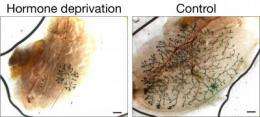Hormone sensitivity of breast stem cells presents drug target

Researchers at the Walter and Eliza Hall Institute have discovered that breast stem cells are exquisitely sensitive to the female hormones oestrogen and progesterone, a finding that opens the way for the development of new preventions and treatments for breast cancer.
The discovery, by scientists in the institute's Stem Cells and Cancer and Bioinformatics divisions, also explains decades of evidence linking breast cancer risk to exposure to female hormones.
It has been published online today in the international journal Nature.
Dr Jane Visvader, who led the research with Dr Geoff Lindeman, said sustained exposure to oestrogen and progesterone was a well-established risk factor for breast cancer. "There is a clear evidence that the more menstrual cycles a woman has the greater her breast cancer risk," Dr Visvader said. "There is even an increase in breast cancer risk in the short-term following pregnancy. However the cellular basis for these observations has been poorly understood."
In the mid-2000s, Drs Visvader and Lindeman discovered breast stem cells in both mice and humans. Unexpectedly, however, they also found that breast stem cells lacked 'receptors' that would allow them to be directly controlled by the female hormones oestrogen and progesterone.
Now, work by Drs Visvader and Lindeman in collaboration with Drs Marie-Liesse Asselin-Labat, Gordon Smyth and others at the institute, has revealed that despite lacking receptors for oestrogen and progesterone, breast stem cells are still remarkably sensitive to female hormones.
Using mouse models, they showed that when the ovaries were removed or the animals were treated with hormone inhibitors (which are in clinical use as anti-breast cancer agents), breast stem cell numbers dropped and the cells appeared to become dormant.
Dr Lindeman, who is also a medical oncologist at the Royal Melbourne Hospital, said this finding helped to explain why the effects of 'chemoprevention' - a treatment aimed at breast cancer prevention continued long after anti-estrogen tablets have been stopped.
"Our research also revealed that during pregnancy there is a profound increase in breast stem cell numbers," Dr Lindeman said.
"This might account for the short-term increase in cancer risk associated with pregnancy."
Further studies, in collaboration with Dr Jack Martin at St Vincent's Institute Melbourne and Dr Hisataka Yasuda at the Nagahama Institute for Biochemical Science, identified the RANK ligand pathway as the key cell-signalling pathway responsible for the indirect control of breast stem cells in pregnancy.
Dr Lindeman said inhibitors of RANK signalling have been developed and are currently in clinical trials to help maintain bone strength and treat breast cancer that has spread to the bones. "Our discovery suggests that inhibitors of RANK or other stem cell pathways represent possible therapeutic strategies that could also be investigated as breast cancer prevention agents," Dr Lindeman said.
















